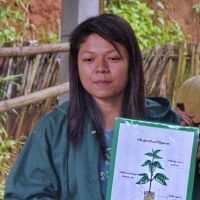Trees and Ground Flora Diversity of Framework Species Plantation Plots and Dong Seng Forest, Mae Rim District, Chiang Mai Province

FORRU Contributors
ABSTRACT: The framework species method (FSM), combined with assisted natural regeneration (ANR) aims to restore forest biomass, structure, biodiversity and ecological functioning to levels similar to those of natural forest. In this study, the forest structure and vegetation diversity of natural forest, was compared with those of 9, 5, and 1-year-old FSM trial plots to determine the progress of restoration in the upper MAe Sa Valley, northern Thailand. Data collected in each plot included tree species, girth at breast height (GBH), height and tree crown dimensions, along three 40x6m transects. Recorded species richness in natural forest was 32 whereas in 9, 5 and 1-year-old FSM plots it was 33, 45 and 45 respectively. Species with highest IVI were Castanopsis diversifolia in natural forest, Spondias axillaris in 9-year-old FSM plots, Acrocarpus fraxinifolius in 5-year-old FSM plots and Prunus cerasoides in the 1 –year-old FSM plots. Similarity among the 4 areas were less than 35%. Tree height and GBH in FSM plots increased with plot age. Tree density in FSM plots was higher than in natural forest, due to the high stocking density when planting.
Twelve 5-m-radius circular sample plots were used at each site for the ground flora study, which included tree saplings smaller than 1 m tall and herbaceous species. The percentage cover of all ground flora species was recorded in the rainy and dry seasons. The most dominant taxa in the ground flora was Gramineae. In the rainy season, diversity was higher than in the dry season, and recorded species composition differed between seasons. Ground flora diversity in the FSM plots was lower than that in natural forest, in both seasons.
Tree diversity in natural forest was studied by using 700 m-survey lines at 3 elevations (1,200, 1,300 and 1,400 m above sea level). 5-m-radius circular plots were positioned at intervals of 25 m, along the lines. All tree species and GBH were recorded in the circular plots. A total of 110 tree species (45 families) were recorded. Tree species diversity was highest at 1,300 m. asl. This may have been due to disturbances at the top and in the lower part of the hill (fire and human activities).
Most of the tree species recorded in natural forest were the same as those of saplings and seedlings in the FSM plots, suggesting active seed dispersal between natural forest and FSM plots, with conditions in the FSM having returned to those conducive for regeneration of most forest-tree species of mature forest. Therefore the FSM can restore tree communities and forest structure, similar to natural forest within 9 years. However, the ground-flora community, particularly herbaceous species, may need longer to recover.

